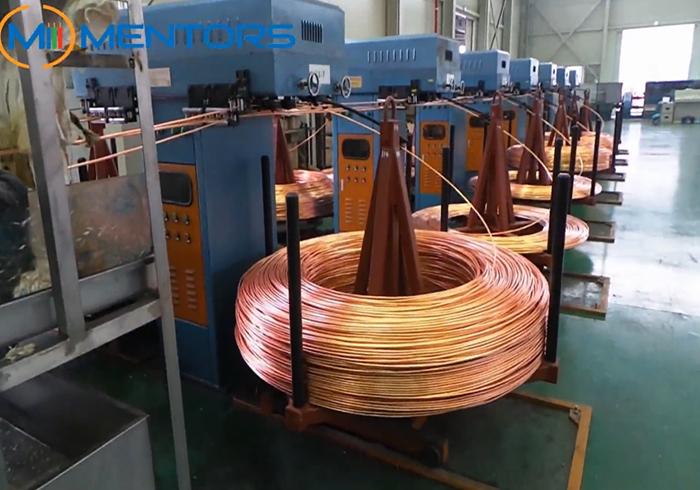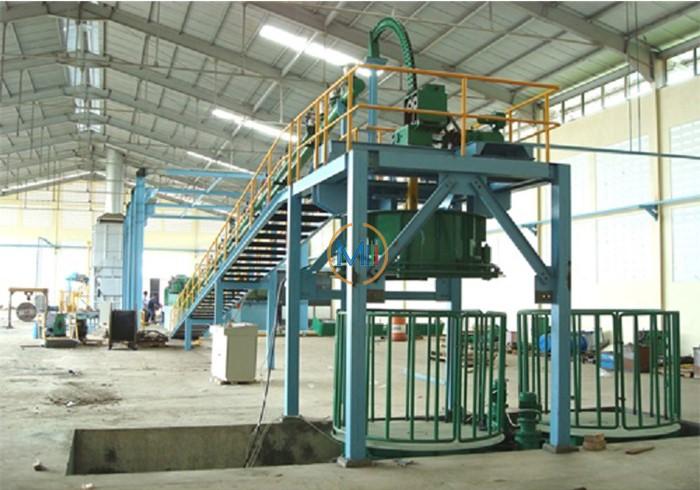Copper rods are fundamental materials for the electrical and electronics industry, widely used in cables, conductors, connectors, and precision components. With the growing demand for efficient power distribution and advanced electronic products, the quality of copper rods is more critical than ever. Choosing the appropriate copper rod manufacturing process is a decisive factor that directly impacts the rod’s conductivity, mechanical properties, structural integrity, and overall suitability for downstream applications.
Among the various methods developed for copper rod manufacturing, Continuous Casting and Rolling (CCR) and Upward Continuous Casting (UCC) are the two mainstream processes. Each of these methods has distinct characteristics, advantages, and application areas. In this article, we will explore both processes in detail and provide a comprehensive guide on how to select the appropriate method based on material requirements, product specifications, and market applications.
1. Overview of Copper Rod Manufacturing
Copper rods are produced by melting high-purity copper cathodes, casting the molten copper into rod shapes, and then processing it to achieve desired physical and mechanical characteristics. The manufacturing process must ensure high purity, uniform grain structure, and optimal electrical and mechanical properties.
The two primary production methods—CCR and UCC—serve different types of copper rods:
CCR (Continuous Casting and Rolling): Best suited for low-oxygen copper rods
UCC (Upward Continuous Casting): Primarily used for oxygen-free copper rods
2. Upward Continuous Casting (UCC) Process

2.1 What is UCC?
The Upcast method is a widely adopted process for producing high-quality copper rods. The basic principle involves melting copper in a crucible and then drawing the molten copper upward through a graphite die to form a solid rod.
The procedure starts with raw material preparation. High-purity electrolytic copper is typically used as the raw material, which undergoes strict inspection to ensure it meets the required purity standards (usually 99.95% or higher). The copper is then cut into small pieces or granules for easier handling and melting.
In the melting stage, the copper is placed in a crucible, which is heated by an electric resistance or induction heating system. The temperature is carefully controlled to around 1100-1150°C, ensuring complete melting of the copper while avoiding overheating, which could lead to oxidation and contamination.
Once the copper is fully molten, the next step is casting. A graphite die, located at the bottom of the crucible, is used to shape the copper rod. The die has a small opening through which the molten copper is drawn upward by a pulling mechanism. As the molten copper passes through the die, it comes into contact with a cooling system surrounding the die, causing it to solidify rapidly. The pulling speed is precisely controlled to ensure the formation of a continuous, uniform copper rod with the desired diameter.
After casting, the copper rod undergoes a series of post-processing steps. These include surface cleaning to remove any oxide layers or contaminants, straightening to correct any bending or deformation, and cutting to the required length. Finally, the finished copper rods are subjected to rigorous quality inspection, including tests for electrical conductivity, dimensional accuracy, and surface quality.
The Upward Continuous Casting (UCC) method is a vertical casting technique primarily used to produce oxygen-free copper rods. In this process, molten copper rises upward through graphite or ceramic molds via capillary action and solidifies into rods.
Main Steps involved:
1) Melting copper in an oxygen-controlled environment
2) Upward casting of rods using mold systems
3) Cooling, surface treatment, and coiling
2.2 Key Characteristics
2.2.1 Used to produce Oxygen-Free Copper (OFC) rods
2.2.2 Oxygen content typically between 10–50 ppm, can be as low as 1–2 ppm
2.2.3 Best suited for ultra-fine wire applications (<0.5mm diameter)
2.3 Advantages of UCC
2.3.1 Exceptional purity
2.3.2 Uniform single-phase microstructure
2.3.3 No hot rolling defects
2.3.4 Excellent for high-precision applications
2.4 Limitations
2.4.1 Lower productivity
2.4.2 Higher cost per ton
2.4.3 Limited rod size range
3. Continuous Casting and Rolling (CCR) Process

3.1 What is CCR?
The Continuous Casting and Rolling method is another major process for copper rod production, known for its high efficiency and suitability for large-scale production. The process integrates casting and rolling into a continuous operation, eliminating the need for intermediate handling and cooling steps.
Raw material preparation for the CCR method is more flexible compared to the Upcast method. It can use both electrolytic copper and recycled copper scrap, provided that the scrap is properly processed and purified to meet the required quality standards. The raw materials are melted in a large furnace, such as a reverberatory furnace or an electric arc furnace. The melting temperature is maintained at approximately 1200-1250°C to ensure thorough melting and homogenization of the copper.
In the continuous casting stage, the molten copper is poured into a water-cooled mold, which shapes it into a solid billet. The mold is designed to allow continuous withdrawal of the billet as new molten copper is poured in. The cooling rate is controlled to ensure proper solidification of the billet, which affects its microstructure and mechanical properties.
The solidified billet is then immediately transferred to the rolling mill, where it undergoes a series of rolling passes. The rolling process reduces the diameter of the billet and increases its length, while also improving its mechanical properties through work hardening. The number of rolling passes and the reduction ratio are determined based on the desired final diameter and mechanical properties of the copper rod.
After rolling, the copper rod is cooled to room temperature and subjected to surface treatment, such as pickling or coating, to improve its corrosion resistance and surface finish. It is then cut to the required length and inspected for quality, including checks for dimensional accuracy, mechanical strength, and electrical conductivity.
The Continuous Casting and Rolling (CCR) mainly includes following steps:
1) Melting of Copper Cathodes
2) Continuous Casting into Rod Form
3) Hot Rolling
4) Pickling and Cleaning
5) Cooling
6) Coiling or Spooling
3.2 Key Characteristics
3.2.1 Used to produce Electrolytic Tough Pitch Copper (ETP) rods
3.2.2 Final rods contain 0.02%–0.04% oxygen (200–400 ppm)
3.2.3 Suitable for large-diameter wire drawing (typically >1mm)
3.3 Advantages of CCR
3.3.1 High production efficiency
3.3.2 Lower operational cost
3.3.3 Uniform rod dimensions
3.3.4 Good surface quality
3.4 Limitations
3.4.1 Not ideal for ultra-fine wire drawing
3.4.2 Lower ductility and toughness
3.5 Material Requirements
3.5.1 Copper Cathode Purity: The raw copper used in CCR should have a purity of at least 99.90% (T2 grade) or higher. Higher-purity cathodes, such as 99.95% (T1), are preferred when superior conductivity is required.
3.5.2 Oxygen Content: Acceptable oxygen content ranges from 200 to 400 ppm. This range ensures the material maintains good castability and electrical performance.
3.5.3 Physical Form: Copper cathodes should be clean, flat, and free of contamination to ensure stable melting and casting.
3.5.4 Additives: In some cases, trace alloying elements may be introduced to improve specific properties like strength or corrosion resistance, but for most applications, pure copper is used.
4. Factors to Consider When Choosing a Copper Rod Manufacturing Process
4.1 End-Use Application: High-end electronics require UCC: standard cables suit CCR.
4.2 Wire Diameter Requirements: Fine wires need the ductility of UCC rods.
4.3 Conductivity and Purity Needs: UCC is often preferred where high purity is mandatory.
4.4 Cost Consideration: CCR offers lower costs per ton.
4.5 Production Scale and Investment: CCR is better for mass production.
5. Comparative Summary Table
| Feature | CCR | UCC |
| Oxygen Content | 200-400 ppm | <50 ppm |
| Purity | High | Very High |
| Ductility | Moderate | Excellent |
| Surface Quality | Good | Excellent |
| Suitable Wire Diameter | >1mm | <0.5mm |
| Cost | Lower | Higher |
| Productivity | High | Medium |
| Application | Power cables, general wiring | Electronics, precision wires |
6. Practical Recommendations
6.1 Mass producers should choose CCR for cost-efficiency.
6.2 High-precision or electronic applications should use UCC.
6.3 Mixed product lines may benefit from both processes.
6.4 R&D teams should prefer UCC for experimental or high-performance copper wires.
7. Future Outlook
7.1 Adoption of green production technologies
7.2 Hybrid CCR-UCC technologies in development
7.3 AI-assisted quality control
While CCR excels in productivity and cost-effectiveness, UCC leads in purity and suitability for precision applications. Choosing the right copper rod manufacturing process is essential to achieving the desired balance of quality, cost, and performance. Click here to see the running video of Copper Rod Upcasting Machine.
NOTE:All rights reserved, Reprinting is prohibited without permission
